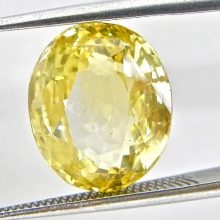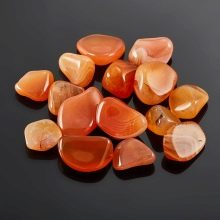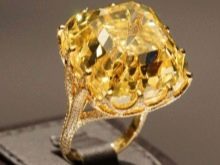Yellow stones: types, applications, who are they suitable for?

Semi-precious and yellow gemstones are in demand and are valued for their amazing appearance. Such minerals look very elegant and sophisticated in jewelry. In addition, the yellow mineral, associated with warmth and sun, is endowed with healing and miraculous powers that can redirect a person's life for the better and improve his health. A yellow tint adjusts a person to love of life and gives him a festive mood.
The bright color of the stone is associated with a heavenly body and awakening, so it sets a person up for vigorous action.



Types and their properties
The structure of yellow stones mainly contains components such as lithium, sulfur or 3-valent iron. The amount of these compounds determines the color saturation of the nugget. In natural conditions, there are quite a few types of semiprecious, precious, ornamental and decorative minerals of the corresponding range, including stones:
- dark yellow and light yellow color;
- golden color;
- with an orange tone;
- lemon tonality;
- with brown splashes.



In specialized catalogs you can find all kinds of photographs and names of yellow stones.
Stones by origin are divided into inorganic and relatively inorganic types. A clear example of the first category - a yellow diamond - comes across very rarely. Only 1 in 100 thousand nuggets include lithium and are golden in color, and in most cases colorless minerals are mined. Amber is related to relatively inorganic stones. The yellow color of amber is not associated with impurities in its structure, since this color is due to the presence of resin in the composition.
Many useful qualities are attributed to stones of the solar range. According to fans of stone therapy, natural minerals of yellow color have the ability to cheer up, inspire cheerfulness, activate vitality. In esotericism, a gold-colored stone is known as a talisman with power against damage and the evil eye. Since the yellow minerals are called solar minerals, they are recommended for protection from energy vampires and evil spirits.
Yellow stones are classified according to the characteristics of the hardness of the structure and as they spread. Conditionally allocate semi-precious and precious stones, semi-precious and decorative minerals.


Precious
- Topaz. It is a bright yellow vitreous crystal with a multicolored sheen. Individual yellow variations show the phenomenon of multicolor - a combination of several colors in one mineral. Usually in such samples, yellow colors are mixed with pink, brownish, greenish and reddish tones.
All samples of this color are classified as "champagne", and their cost ranges from 200 to 600 USD per carat. You can see yellow topaz in earrings, pendants and rings. Often they are in the company of other precious minerals such as diamonds.
The cost of such items with a large number of gems and precious metal can reach more than one thousand dollars.


- Sapphire (yacht). It is a transparent or translucent type of corundum. It is one of the hardest minerals after diamond., and yellow is the rarest phenomenon. In the distant past, the yellowish yacht was called the eastern peridot, and the orange-yellow padparadscha.
Jewelry makers and repairers cut the crystal like a diamond and insert it into original pieces of jewelry. Rings, pendants or earrings with this stone cost thousands of dollars due to the peculiarity of their inserts.

- Spinel. The yellow stone is mined in small quantities in Afghanistan and India. This color is quite rare for a mineral, but it is of no obvious interest to jewelers. Minerals do not have an intense color, however, their high refractive index and impeccable translucency make them unusual.
They are brought to readiness with a diamond or stepped (ladder) cut and placed in earrings and rings. The cost of yellow spinel can go up to 700 USD per carat.

- Tourmaline. The yellow-brown stone has the name dravit. It is a not widespread type of mineral that is currently mined in only 2 deposits in Kenya. Often the stone demonstrates heterogeneous colors and multiple blotches. With qualified processing, the translucent mineral acquires extraordinary qualities.
Its crystals are used to create rings, earrings, pendants. The price of such items made of gold ranges from $ 100 to $ 1000.

Semi-precious
This group is more common than yellow colored precious minerals. Such samples are especially in demand among jewelers.
- Heliodor... It is also called yellow beryl. A yellowish color in this embodiment can be represented by a large number of halftones. Based on the quality of the stone, jewelers can leave it in its natural form, or they can heat it, as a result of which the mineral will be blue or transparent.
This stone brings to its owners self-confidence, attractiveness and protects from depression. It has a beneficial effect on the nervous system, saving from nightmares and insomnia.
Promotes good family relationships and career advancement.

- Citrine. It is a glassy golden yellow variety of quartz. It stands out for its excellent workability and rare characteristics, which makes it possible to make noteworthy jewelry from it.
Some samples are cut as cabochons, while the rest are cut. Based on the finishing method and the type of metal in the frame, jewelry can be related to the daytime or evening category and cost from 2,000 to 20,000 rubles.

- Garnet... With a yellow color it is rare and of little value. Cabochons and beads are made from pomegranate, very rarely craftsmen give them the configuration of precious minerals, cutting with a ladder or using a fancy cut. In jewelry, yellow garnet can be in harmony with synthetic monocrystals or with its own red counterparts.
The price of earrings, beads, bracelets or pendants with a mineral is several thousand rubles. Basically, the cost of such jewelry is determined by the type of precious metal of the frame, and not by the stones.

- Zircon... It is a fragile mineral that does not tolerate chemical attack. It is a natural substitute for diamond with a proper brilliance, the price of which is several times lower. The stone comes in a variety of colors, including yellow and golden hues.
The professionally processed stone has excellent iridescent reflections. Jewelers rarely use such zircon, but nevertheless, jewelry with it is characterized by a luxurious appearance and elegance. A carat of such a crystal will cost from 300 to 400 USD, and earrings or a pendant with a mineral can become a good jewelry accessory for an evening reception.


Ornamental
The main feature of ornamental and ornamental minerals is that they are opaque and do not have a glassy sheen. Yellow stones are abundant among them. The most affordable is amber. A long time ago, he possessed a second name - the sun stone. Amber is solidified pieces of resin from coniferous trees, which can sometimes be millions of years old.
It is a completely organic mineral that is not considered rare. Relatively inexpensive, it is used wherever possible and even for medicinal purposes. This is due to the large number of trace elements contained in its composition. In particular, there is iodine, thanks to which amber gives good results in the fight against diseases of the endocrine gland.
Carnelian (or carnelian) was formed as a result of volcanic activity. Its color is uneven, with a lot of stripes and circles. Humanity has known him for over 800 thousand years. In ancient times it was in demand for the manufacture of means of production, and in our time it is needed for the decoration of icons and sometimes used to decorate pieces of furniture.
The healing qualities are not found in any such mineral, but exclusively in the one that contains radium. Its presence strengthens the immune system and accelerates the healing of wounds. In addition, carnelian improves health for heart disease.



Application
Colored stones have been used for a long time for jewelry making... Craftsmen often use semi-precious and precious yellow minerals for their work. Especially in demand are multicolored transparent stones, which give jewelry a rich and sophisticated look.
These are, for example, products with yellow diamonds, topaz or sapphires, moreover, minerals of honey and golden colors often coexist with crystals of other shades. Decorative and ornamental patterns are used for making rings, pendants, necklaces, earrings and beads.
Gems, in particular, samples of the category of chalcedony, are used to decorate the interior decoration of rooms, inlay paintings, mirrors and vases.



Choice and care
Solar color is typical for semi-precious and precious minerals.Yellow stones (citrine, jasper, tiger's eye, carnelian, amber, etc.) are suitable for initiative people thirsty for novelty. Stones of this color have the ability to preserve warm family relationships, and also help to gather as much as possible and make the only right decision at the right time.
Caring for jewelry made from natural stones is easy. In order for the products to retain their appearance and caress the eyes of those around, it is enough to follow the basic recommendations:
- avoid contact of the mineral with perfumery and cosmetics;
- you need to store stones in special jewelry boxes;
- do not use chemicals to clean gems, but use only water and soap;
- opaque minerals need to be wiped down occasionally with a soft cloth to maintain their radiance.



Nature has given people a huge variety of minerals. Most of them are rich in color palette, among which yellow colors are often found.
All yellow minerals are associated with the sun and its warmth, carry within themselves a supply of positive energy, which makes our reality better, more colorful and soulful.
Saturated solar minerals will decorate any person and his home, give optimism and awaken zest for life. And with proper care, they will be attractive and will give to their owner own positive energy.
Read more about citrine in the next video.








